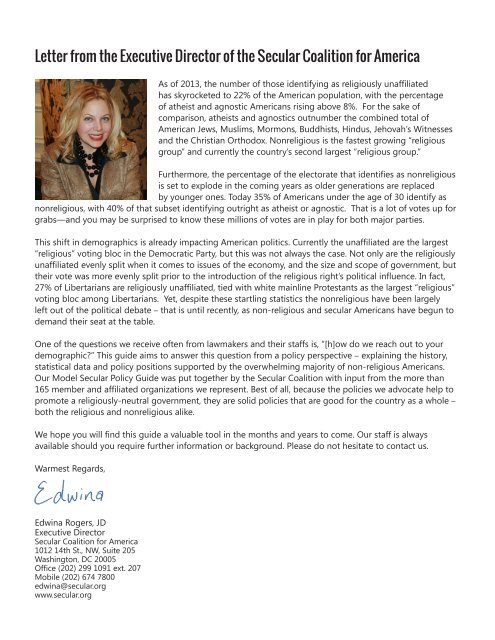Model Secular Policy Guide.pdf
Create successful ePaper yourself
Turn your PDF publications into a flip-book with our unique Google optimized e-Paper software.
Letter from the Executive Director of the <strong>Secular</strong> Coalition for AmericaAs of 2013, the number of those identifying as religiously unaffiliatedhas skyrocketed to 22% of the American population, with the percentageof atheist and agnostic Americans rising above 8%. For the sake ofcomparison, atheists and agnostics outnumber the combined total ofAmerican Jews, Muslims, Mormons, Buddhists, Hindus, Jehovah’s Witnessesand the Christian Orthodox. Nonreligious is the fastest growing “religiousgroup” and currently the country’s second largest “religious group.”Furthermore, the percentage of the electorate that identifies as nonreligiousis set to explode in the coming years as older generations are replacedby younger ones. Today 35% of Americans under the age of 30 identify asnonreligious, with 40% of that subset identifying outright as atheist or agnostic. That is a lot of votes up forgrabs—and you may be surprised to know these millions of votes are in play for both major parties.This shift in demographics is already impacting American politics. Currently the unaffiliated are the largest“religious” voting bloc in the Democratic Party, but this was not always the case. Not only are the religiouslyunaffiliated evenly split when it comes to issues of the economy, and the size and scope of government, buttheir vote was more evenly split prior to the introduction of the religious right’s political influence. In fact,27% of Libertarians are religiously unaffiliated, tied with white mainline Protestants as the largest “religious”voting bloc among Libertarians. Yet, despite these startling statistics the nonreligious have been largelyleft out of the political debate – that is until recently, as non-religious and secular Americans have begun todemand their seat at the table.One of the questions we receive often from lawmakers and their staffs is, “[h]ow do we reach out to yourdemographic?” This guide aims to answer this question from a policy perspective – explaining the history,statistical data and policy positions supported by the overwhelming majority of non-religious Americans.Our <strong>Model</strong> <strong>Secular</strong> <strong>Policy</strong> <strong>Guide</strong> was put together by the <strong>Secular</strong> Coalition with input from the more than165 member and affiliated organizations we represent. Best of all, because the policies we advocate help topromote a religiously-neutral government, they are solid policies that are good for the country as a whole –both the religious and nonreligious alike.We hope you will find this guide a valuable tool in the months and years to come. Our staff is alwaysavailable should you require further information or background. Please do not hesitate to contact us.Warmest Regards,Edwina Rogers, JDExecutive Director<strong>Secular</strong> Coalition for America1012 14th St., NW, Suite 205Washington, DC 20005Office (202) 299 1091 ext. 207Mobile (202) 674 7800edwina@secular.orgwww.secular.org


